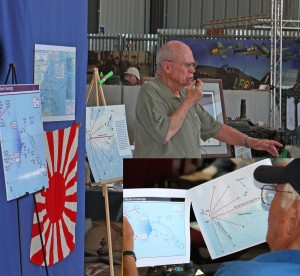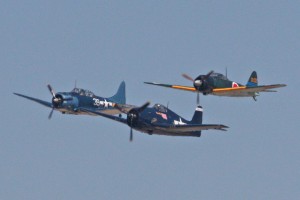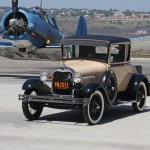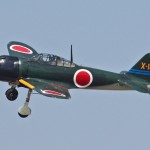By Harlis Brend
The Commemorative Air Force (CAF) Southern California Wing held a special event on Sept. 6, 2008, at their Camarillo Airport facility to honor and remember the Battle of Midway. The event featured guest speaker retired U.S. Army Col. James Hinckley, who spoke in detail about the naval battle near Midway Island June 3-6, 1942. Hinckley is a long-time CAF Southern California Wing member and volunteer and is on the Fairchild 24 restoration team.
According to historical sources, the Battle of Midway is regarded as the most important naval battle of the Pacific campaign during World War II.[1] The U.S. Navy decisively defeated the Japanese naval forces six months after the attack on Pearl Harbor. The heavy losses permanently weakened the Japanese navy. As the result of the Midway victory, the U.S. Navy was able to go on the offensive in the Pacific.
The Japanese plan was to lure America’s few remaining carriers into a trap and sink them.[2] They also intended to occupy Midway Atoll to extend their defensive perimeter, conduct further attacks against Fiji and Samoa, and launch an invasion of Hawaii.[3] U.S. Naval Intelligence broke the code used by the Imperial Japanese Navy in all of their radio transmissions, and that’s how the U.S. Navy learned of the impending attack on Midway Island. Admiral Chester W. Nimitz, commander-in-chief over the Pacific Ocean areas, entered the battle with a clear picture of where, when and with what force the Japanese would attack. In contrast, Japanese Admiral Isoroku Yamamoto remained almost completely in the dark about their opponents even after the battle began.[4]
The Japanese navy lost 332 aircraft, four aircraft carriers (Akagi, Kaga, Soryu and Hiryu), one Mogami class cruiser (Mikuma) and 3,500 men, including over 200 experienced naval aviators.[5] The U.S. Navy lost 98 aircraft, one aircraft carrier (USS Yorktown), one destroyer (USS Hammann) and 307 men.
U.S. Navy/Marine aircraft involved were B-17 bombers, B-26 Marauders, TBF Avengers, TBD Devastator torpedo bombers, SBD Dauntless dive bombers, F4F Wildcat fighters and PBY scout planes. Japanese aircraft involved were primarily the Mitsubishi A6M3 Zero.
The aircraft fly-over after Hinckley’s presentation featured airplanes that were representative of those involved in the Battle of Midway. The most significant aircraft from the Battle of Midway—the Douglas SBD-5 Dauntless dive bomber (which damaged and sank three Japanese carriers within six minutes)—was courtesy of the Planes of Fame Air Museum at the Chino Airport. The Camarillo CAF Zero and F6F-5 Hellcat (a substitute for the unavailable F4F Wildcat) completed the formation. Additional displays included a F8F-2 Bearcat, SNJ, P-51, PT-19, antique cars and museum exhibits.
Remembering Pearl Harbor on Dec. 6, 2008
The next CAF Southern California Wing special event, commemorating Pearl Harbor, will be held on Saturday Dec. 6, 2008, from 10 a.m. to 4 p.m. at the Camarillo Airport CAF facility. Retired U.S. Army Col. James Hinckley will take the podium at 1 p.m. Aircraft and antique cars from that era will be on display and in action. The event is free to veterans of the U.S. Armed Forces. The standard admission donation is $7 for adults, $4 for students and $3 for children).
- Antique cars (1929 Ford) were also on display.
- The Mitsubishi Zero was the primary Japanese aircraft involved in the Battle of Midway.
- The F6F Hellcat replaced the F4F Wildcat that was used during the Battle of Midway.
- The SBD Dauntless dive bombers damaged/sank three Japanese carriers in six minutes.

















